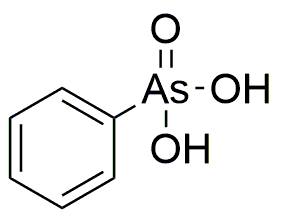Phenylarsonic acid is widely utilized in research focused on:
- Agriculture: Used as a feed additive in livestock to promote growth and improve feed efficiency, helping farmers enhance productivity.
- Pharmaceuticals: Investigated for its potential in developing treatments for certain diseases, offering new avenues for drug discovery.
- Environmental Science: Employed in studies assessing the impact of arsenic compounds in ecosystems, aiding in pollution control and remediation efforts.
- Analytical Chemistry: Serves as a standard in various analytical methods, ensuring accurate measurement and quality control in laboratories.
- Material Science: Explored for its role in synthesizing novel materials, contributing to advancements in electronics and nanotechnology.
General Information
Properties
Safety and Regulations
Applications
Phenylarsonic acid is widely utilized in research focused on:
- Agriculture: Used as a feed additive in livestock to promote growth and improve feed efficiency, helping farmers enhance productivity.
- Pharmaceuticals: Investigated for its potential in developing treatments for certain diseases, offering new avenues for drug discovery.
- Environmental Science: Employed in studies assessing the impact of arsenic compounds in ecosystems, aiding in pollution control and remediation efforts.
- Analytical Chemistry: Serves as a standard in various analytical methods, ensuring accurate measurement and quality control in laboratories.
- Material Science: Explored for its role in synthesizing novel materials, contributing to advancements in electronics and nanotechnology.
Documents
Safety Data Sheets (SDS)
The SDS provides comprehensive safety information on handling, storage, and disposal of the product.
Product Specification (PS)
The PS provides a comprehensive breakdown of the product’s properties, including chemical composition, physical state, purity, and storage requirements. It also details acceptable quality ranges and the product's intended applications.
Certificates of Analysis (COA)
Search for Certificates of Analysis (COA) by entering the products Lot Number. Lot and Batch Numbers can be found on a product’s label following the words ‘Lot’ or ‘Batch’.
*Catalog Number
*Lot Number
Certificates Of Origin (COO)
This COO confirms the country where the product was manufactured, and also details the materials and components used in it and whether it is derived from natural, synthetic, or other specific sources. This certificate may be required for customs, trade, and regulatory compliance.
*Catalog Number
*Lot Number
Safety Data Sheets (SDS)
The SDS provides comprehensive safety information on handling, storage, and disposal of the product.
DownloadProduct Specification (PS)
The PS provides a comprehensive breakdown of the product’s properties, including chemical composition, physical state, purity, and storage requirements. It also details acceptable quality ranges and the product's intended applications.
DownloadCertificates of Analysis (COA)
Search for Certificates of Analysis (COA) by entering the products Lot Number. Lot and Batch Numbers can be found on a product’s label following the words ‘Lot’ or ‘Batch’.
*Catalog Number
*Lot Number
Certificates Of Origin (COO)
This COO confirms the country where the product was manufactured, and also details the materials and components used in it and whether it is derived from natural, synthetic, or other specific sources. This certificate may be required for customs, trade, and regulatory compliance.


